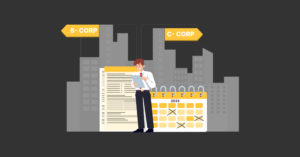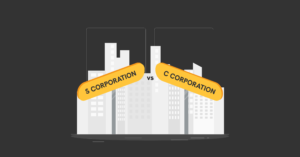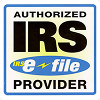Navigating S Corporation Taxes
Navigating S corporation taxes can be straightforward with the right guidance. This article serves as a comprehensive resource for filing taxes for your S corporation, ensuring you meet your obligations efficiently. Regardless of your experience level, understanding S corporation taxes is crucial for maximizing deductions and minimizing errors.
We will discuss Form 1120-S, the vital document for your tax filing. You’ll learn about the key requirements and deadlines, as well as common mistakes to avoid. Additionally, we will explore how tools like X.tax can streamline the tax process, allowing you to focus on growing your business. Join us as we clarify the essentials of S corporation taxes and empower you to take charge of your financial responsibilities.
Understanding S Corporation Taxes
An S Corporation combines the benefits of corporate status with the advantage of pass-through taxation. This structure allows income to be passed directly to shareholders, avoiding the double taxation that C Corporations face. In essence, S Corporations allow dividends to be reported on individual tax returns rather than at the corporate level.
For instance, if an S Corporation earns $100,000, that entire amount is distributed to shareholders, who then report it on their personal tax returns based on their ownership percentage. This mechanism can lead to potential tax savings, as shareholders may benefit from lower individual tax rates compared to corporate rates.
Furthermore, S Corporations provide flexibility in profit and loss distribution. Shareholders can report either income or losses from the S Corporation on their tax returns without incurring corporate-level taxes. This setup not only enhances tax efficiency but also supports better cash flow and financial planning for businesses.
Understanding S Corporation taxes is crucial for business owners because it significantly influences their overall tax liability. By carefully planning and adhering to tax regulations, owners can foster a beneficial tax environment and maximize their tax efficiency.
With a solid grasp of S Corporation taxes, it’s important to turn our attention to the filing process. Next, we’ll examine Form 1120-S, which is the primary document for reporting an S Corporation’s income and taxes to the IRS.
Form 1120-S: Essential for S Corporation Taxes
Form 1120-S is the vital document for handling S corporation taxes, as every S corporation must submit this form to the IRS. This form is used to report income, deductions, and other tax-related information for federal compliance.
It is important for S corporation owners to be aware that Form 1120-S must be filed annually, regardless of whether the corporation engaged in business activities or generated income. This requirement is mandatory; failure to submit the form can incur penalties of $195 per month, totaling up to a maximum of $2,400.
The filing deadline for Form 1120-S usually falls on the 15th day of the third month following the end of the corporation’s tax year. For example, if your corporation’s tax year follows the calendar year, the due date will be March 15. Missing this deadline can result in additional penalties and interest on any owed taxes.
Having a solid understanding of how to complete Form 1120-S is crucial for managing S corporation taxes effectively. By grasping this process, business owners can ensure timely and accurate filings, which not only simplifies compliance but also reduces stress associated with tax obligations.
Key Steps to Completing Form 1120-S
Filing S corporation taxes can be straightforward if you approach it step by step. Begin by collecting essential documents like financial statements, your Employer Identification Number (EIN), and any records supporting your income and deductions. Having these ready will simplify the process.
Next, fill in the required corporate details on Form 1120-S, including the incorporation date and business address. Providing accurate information is vital for ensuring compliance with IRS regulations.
When reporting income and deductions, be thorough. Make a complete list of all income sources and deductible expenses from the year. Accuracy is critical, as incorrect reporting could lead to audits or penalties. Double-check your figures to avoid mistakes.
Additionally, include the necessary shareholder information for Schedule K-1 forms. Each shareholder needs to receive a K-1 outlining their share of earnings, losses, credits, and deductions for their personal tax returns. Omitting this information can cause confusion and may result in costly corrections.
Finally, ensure you submit Form 1120-S by the deadline, which generally falls 15 days after the end of the tax year for S corporations. Timely filing is essential for remaining compliant with IRS rules and avoiding potential issues.
By carefully following these steps, you can alleviate the stress associated with filing your S corporation taxes, leading to a smoother process. Once you have completed these steps, you can shift your focus toward maximizing the deductions available on your S corporation tax return.
Maximizing Deductions on Your S Corporation Taxes
To effectively minimize your taxable income for S corporation taxes, it’s important to fully utilize available business deductions. These deductions can significantly lower your tax burden, improving your overall financial health.
Common deductions for S corporations include employee wages, rent for office space, and operational costs such as utilities and supplies. For example, by deducting wages, you can decrease your taxable income while enhancing cash flow.
Organized record-keeping is crucial for supporting your deductions. The IRS requires that all deductions claimed on Form 1120-S be backed by proper documentation, including receipts and invoices for your business expenses. Without adequate documentation, you risk facing challenges during an audit, which can lead to tax adjustments and lost savings.
By understanding the eligible deductions and maintaining precise records, you lay the foundation for successful S corporation tax filings. In the next section, we will discuss the filing requirements and deadlines that every S corporation must adhere to in order to remain compliant and avoid penalties.
Filing Requirements and Deadlines for S Corporations
To manage S corporation taxes effectively, it is essential to understand the filing deadlines. The deadline for submitting Form 1120-S, the S corporation tax return, is the 15th day of the third month after the end of the tax year. For most S corporations operating on a calendar year, this means the return is due by March 15.
S corporations can apply for an automatic six-month extension by filing Form 7004. This extension moves the deadline to September 15, but it is important to note that it does not extend the time to pay any taxes owed. S corporations are still required to calculate and pay estimated taxes by the original due date to comply with their tax obligations.
Being mindful of these filing requirements and deadlines simplifies the tax preparation process. Timely submissions and proper planning can significantly reduce the stress associated with tax season, helping you avoid last-minute complications.
In the following section, we will discuss some common mistakes to avoid when filing S corporation taxes. Being aware of these pitfalls will help you navigate the filing process more smoothly.
Common Mistakes to Avoid When Filing S Corporation Taxes
Filing S corporation taxes requires precision, as even minor mistakes can lead to significant consequences. A common error is misreporting income and deductions on Form 1120-S, which can trigger an IRS audit and result in back taxes and penalties. It’s essential to accurately report all income, including capital gains and dividends.
Another frequent mistake is missing tax filing deadlines. Form 1120-S is typically due on the 15th day of the third month following the end of the tax year. Late filings incur a penalty of $210 per month, making it crucial to stay on top of these deadlines to avoid additional fees.
Poor recordkeeping can also contribute to filing errors. Maintaining organized financial records is vital for supporting claims during an audit. Always keep receipts and documents accessible for IRS review if necessary.
S corporations must pass-through income to shareholders. Ensuring that K-1 forms are accurate and distributed correctly is important to prevent confusion for shareholders and complications on their personal tax returns.
Finally, consulting tax professionals can provide valuable guidance when navigating S corporation taxes. They can offer insights into tax laws, compliance, and strategies to minimize tax liabilities while identifying often-overlooked deductions.
In summary, careful attention to detail, adherence to deadlines, and proper recordkeeping are essential to avoid issues when filing S corporation taxes.
How X.tax Can Simplify Your S Corporation Tax Filing
Navigating S corporation taxes can be challenging, but X.tax simplifies the process. This platform is tailored for business owners, offering modern technology and straightforward features that streamline tax obligations.
X.tax specializes in S Corporations and similar entities, making it invaluable for managing Form 1120-S filings. It ensures accurate deductions while maintaining compliance with IRS regulations. This targeted approach helps minimize errors and effectively meets your specific tax needs.
In addition to its focused services, X.tax saves time by integrating with popular accounting systems. The automation of data imports and calculations significantly reduces tax preparation time, allowing small to medium-sized businesses to focus on growth without needing extensive accounting resources.
Designed with user-friendliness in mind, X.tax caters to business owners of all backgrounds. Its intuitive interface simplifies navigation, making it accessible even for those with limited financial knowledge. With step-by-step guidance and responsive customer support, users can confidently complete their S corporation taxes while minimizing errors.
In summary, X.tax goes beyond being a mere tax filing tool. By offering specialized services, saving time through integrations, and providing an easy-to-use interface, it is essential for navigating the complexities of S corporation taxes in today’s fast-paced business world.
Conclusion
Understanding S corporation taxes can be straightforward. We covered Form 1120-S, essential filing steps, and strategies to maximize your deductions. By knowing the filing requirements and deadlines, you can avoid common pitfalls and streamline the process.
It’s time to take action. Start by organizing your records and following the outlined steps. Consider using helpful tools like X.tax to simplify your filing. Being proactive and well-informed will ease the challenges of tax season.
Implement these strategies to handle your tax obligations. The efforts you invest now will lead to a smoother filing experience in the future.
About x.tax
x.tax is a comprehensive platform designed for seamless business tax filing, catering to partnerships, S corporations, C corporations, and estates & trusts. With its innovative approach to tax preparation, x.tax simplifies the process, helping business owners save time and reduce complexity in managing their tax obligations.
Don’t let tax season overwhelm you—experience the efficiency of x.tax today. Get started now!









